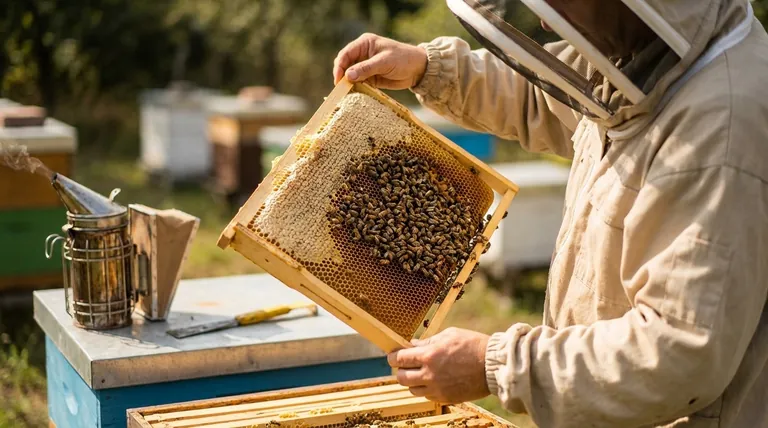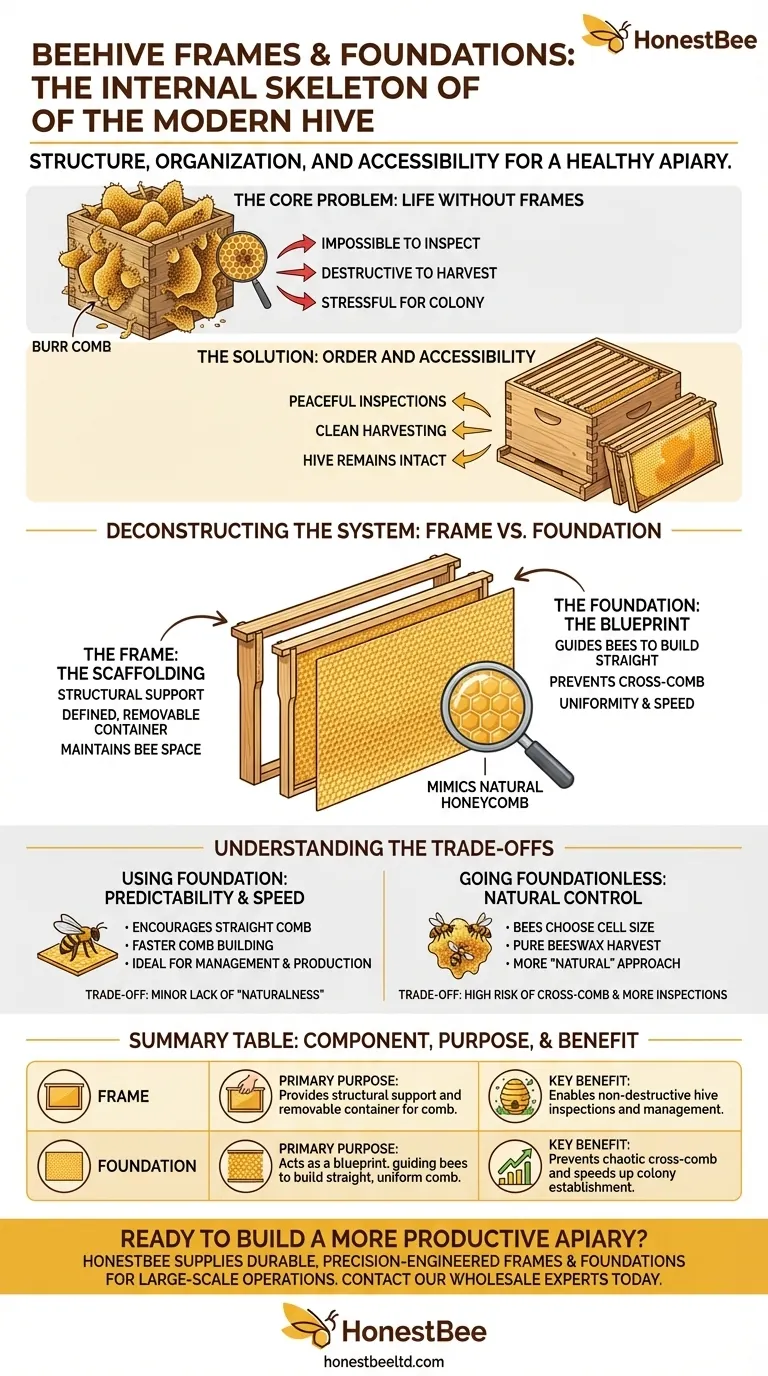In short, beehive frames and foundations are the internal skeleton of the modern hive. They provide a structured, removable system for bees to build their honeycomb. This innovation allows beekeepers to inspect the colony's health, manage its growth, and harvest honey without destroying the hive itself.
The central purpose of frames and foundations is to transform a potentially chaotic colony into an organized, manageable system. By giving bees a clear blueprint for building, this system ensures the hive remains healthy, productive, and accessible for the beekeeper.

The Core Problem: Why Structure is Non-Negotiable
To understand the purpose of frames, you must first understand what happens without them. A honeybee colony's natural instinct is to build comb to fill any available space, creating an intricate and permanent structure.
Life Without Frames
In a simple, empty box, bees will build comb attached to the walls, the lid, and other combs. This interconnected mass, often called burr comb, is impossible to inspect without cutting it apart.
This destructive process would kill brood, spill honey, and severely stress the entire colony, making sustainable beekeeping impossible. You would have no way to check for disease, verify the queen's health, or harvest surplus honey cleanly.
The Goal: Order and Accessibility
Frames solve this problem entirely. As removable structures that fit neatly inside the hive boxes, they provide a space for bees to build individual sections of comb.
Because the comb is contained within the frame, the beekeeper can lift each one out individually. This allows for peaceful, methodical inspections and a simple, clean honey harvesting process that leaves the core of the hive intact.
Deconstructing the System: Frame vs. Foundation
While they work together, the frame and the foundation have distinct roles. Think of it as a picture frame and the canvas inside it.
The Frame: The Scaffolding
The frame is the outer structure, typically made of wood or plastic, that holds the honeycomb. Its primary purpose is to provide structural support and a defined, removable container for a single sheet of comb.
The dimensions of the frame are precisely calculated to maintain "bee space" around it, preventing the bees from gluing the frames to the hive walls or to each other.
The Foundation: The Blueprint
The foundation is a thin sheet of plastic or beeswax that fits inside the frame. It is typically imprinted with a hexagonal pattern that mimics the base of natural honeycomb.
This sheet acts as a guide, or blueprint, encouraging the bees to build their wax comb straight and within the confines of the frame. This ensures the comb is uniform and easy to remove, preventing the chaotic cross-comb that can make a hive unmanageable.
Understanding the Trade-offs
While the frame-and-foundation system is standard, beekeepers have choices that come with specific advantages and disadvantages.
Using Foundation: Predictability and Speed
The vast majority of beekeepers use foundation. It strongly encourages bees to draw straight comb, which is critical for beginners and anyone focused on ease of management and honey production. Bees can also build out comb faster on foundation since the base is already started for them.
The downside is a minor lack of "naturalness," as you are dictating the size of the cells the bees will build.
Going Foundationless: Natural Control
Some beekeepers prefer to use frames without any foundation. This allows the bees to build comb of whatever cell size they choose, which is seen as more natural. It's also the only way to harvest completely pure beeswax uncontaminated by foundation material.
The significant trade-off is the high risk of cross-comb, where bees ignore the frame guides and build comb across multiple frames, effectively gluing them together. This requires more frequent and diligent inspections to correct.
Making the Right Choice for Your Goal
Your approach should be dictated by your experience level and your primary objectives as a beekeeper.
- If your primary focus is simplicity and successful hive management: Always start with frames that include foundation, as this system is predictable and forgiving.
- If your primary focus is a more natural approach or pure wax production: You can experiment with foundationless frames after you gain experience managing bee space and performing inspections.
Understanding this fundamental system is the first step toward becoming a confident and effective beekeeper.
Summary Table:
| Component | Primary Purpose | Key Benefit |
|---|---|---|
| Frame | Provides structural support and a removable container for comb. | Enables non-destructive hive inspections and management. |
| Foundation | Acts as a blueprint, guiding bees to build straight, uniform comb. | Prevents chaotic cross-comb and speeds up colony establishment. |
Ready to build a more productive and manageable apiary?
For commercial beekeepers and equipment distributors, the right foundation and frame system is critical for operational efficiency and hive health. HONESTBEE supplies durable, precision-engineered beehive frames and foundations designed for the demands of large-scale operations.
Contact our wholesale experts today to discuss volume pricing and how our equipment can help you achieve superior hive management and honey production.
Visual Guide

Related Products
- Wooden Bee Hive Frames for Beekeeping and Wholesale
- Copper Bee Frame Eyelets for Beekeeping
- HONESTBEE Professional Long Handled Hive Tool with Precision Cutting Blade
- Professional Galvanized Hive Strap with Secure Locking Buckle for Beekeeping
- Wood and Mesh Push-In Queen Cage
People Also Ask
- When should I throw away my bee frames? A Guide to Proactive Hive Health
- What parts of bee equipment should not be painted? Protect Your Hive's Interior for Bee Health
- What color options are available for plastic frames, and what is the benefit of black frames? Boost Your Hive Inspection Efficiency
- Will honey bees clean up old frames? A Guide to Safe and Efficient Frame Reuse
- When should bee frames be thrown away? A Beekeeper's Guide to Hive Health & Biosecurity



















